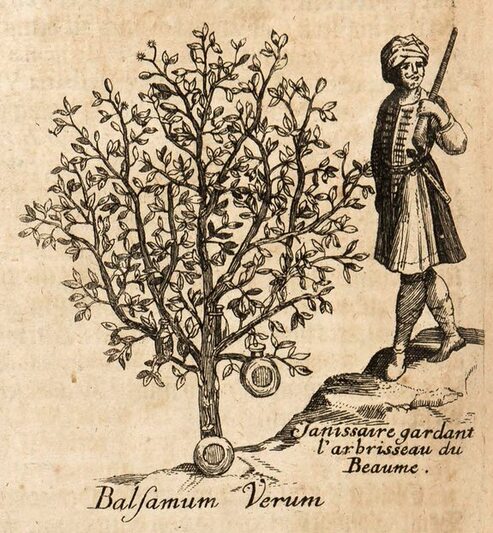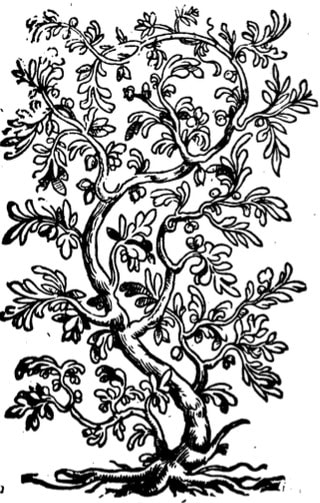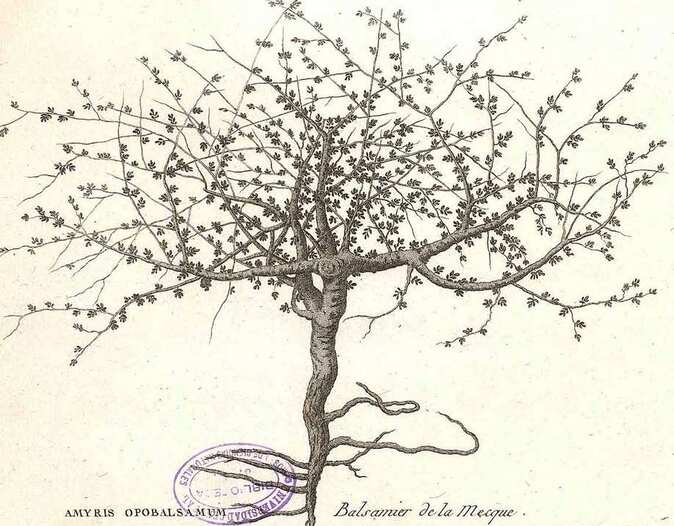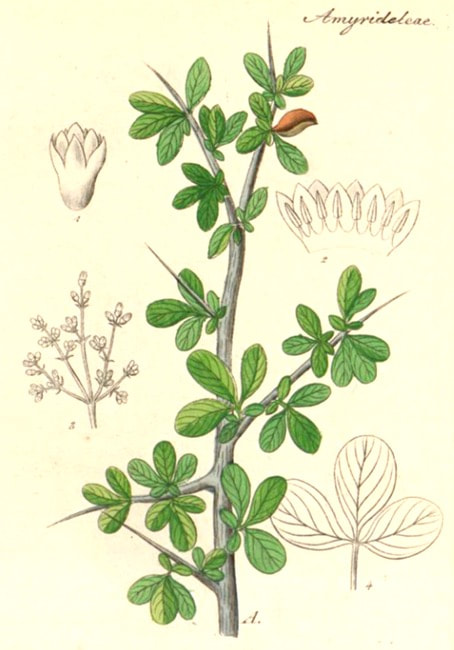Balsam, Balsam tree
Balm of Gilead, Balsam of Judea
Unani:
–Roghan-e-Balsaan (oil)
–Hab-e-Balsaan (fruit)
–Ood-e-Balsaan (wood)
Unani:
–Roghan-e-Balsaan (oil)
–Hab-e-Balsaan (fruit)
–Ood-e-Balsaan (wood)
True Balsam tree with a guard protecting it, indicating its high value
Museum Museorum, Valentini, 1704
Museum Museorum, Valentini, 1704
Krater-Buch und kunstliche Conterfeyungen, 1703
Bruce, Travels to discover the source of the Nile, Cartes et figures du Voyage en Nubie et en Abyssinie, 1792
Hand-Atlas Medicinisch-Pharmaceutischer, 1884
Botanical name:
Commiphora opobalsamum (syn. C. gileadensis; Balsamodendron opobalsamum, B. gileadense; Balsamea gileadensis, B. meccanensis, B. opobalsamum; Amyris gileadensis, A. opobalsamum)
Parts used:
"Fresh balsam constitutes the best quality while that which is old and thick has no potency. The best seeds of balsam are those which have a redish tinge and which are compact, large and heavy". (Avicenna)
Balsam oil comes in a range of colors. Three general types were known by Galen:
Temperature & Taste:
Warm, dry. Aromatic, Pungent.
"Oil is hottest, next the Seeds, then the Wood". (Avicenna)
"The twig of balsam is hot and dry in the second degree, the seeds are comparatively hotter (than the twig) and the oil is hotter than both of them. The oil is hot in the first stage of the third degree". (Avicenna)
Commiphora opobalsamum (syn. C. gileadensis; Balsamodendron opobalsamum, B. gileadense; Balsamea gileadensis, B. meccanensis, B. opobalsamum; Amyris gileadensis, A. opobalsamum)
Parts used:
- Fruit: Carpobalsam;
- Branches (wood): Xylobalsam;
- Oil (gum-resin or 'juice'): Opobalsam
"Fresh balsam constitutes the best quality while that which is old and thick has no potency. The best seeds of balsam are those which have a redish tinge and which are compact, large and heavy". (Avicenna)
Balsam oil comes in a range of colors. Three general types were known by Galen:
- Best is whitish, pungent and sharp
- next is reddish and is like glue
- third type is very thin and transparent.
Temperature & Taste:
Warm, dry. Aromatic, Pungent.
"Oil is hottest, next the Seeds, then the Wood". (Avicenna)
"The twig of balsam is hot and dry in the second degree, the seeds are comparatively hotter (than the twig) and the oil is hotter than both of them. The oil is hot in the first stage of the third degree". (Avicenna)
Uses:
1. Clears Phlegm, Stops Cough:
-Cough (wood, twigs, fruit, seed)
-"The twig and seeds of Balsam are useful in Pleuralgia, severe Asthma, Dyspnoea and Pneumonia. Its seeds are useful in cold Pneumonia and Cough". (Avicenna)
-seeds are useful for Cold Pneumonia and Cough. (Avicenna)
2. Settles Wind-Phlegm, Stops Spasms:
-Epilepsy, Dizziness and nervous diseases (all parts)
-Sciatica (Wood) (Avicenna)
3. Moves Qi, Warms the Stomach:
-Strengthens Stomach, Indigestion, cleanses the Stomach (Avicenna) (Fruit, Wood)
-opens obstructions of the viscera (Avicenna)
4. Moves Blood, Promotes Menstruation:
-Fruit is used.
-decoction of Balsam opens the mouth of the Uterus (Avicenna)
5. Resists Poison:
-antidote for poisons including Hemlock seeds. (Avicenna)
-Snake Bite, Insect Bites especially Scorpion. (Avicenna)
-Balsam oil is useful for shivering (Avicenna)
-purifies Ulcers (Avicenna)
6. Externally:
-anti-inflammatory, eases pain (oil)
-Fumigation with Balsam dries up the moistness or coldness of uterus, expels the foetus and placenta and is useful in all the painful conditions of uterus'. (Avicenna)
Dose:
Oil: 1–3 grams;
Fruit and Wood: 3–5 grams
Comment:
1. Dioscorides said the Juice was most efficacious, next the Fruit, and lastly, the Wood.
2. Various parts of the Balsam tree were often used in classical formula. They were not used alone. But as Schroder noted, even centuries ago they were often unavailable in Europe, so a series of common substitutes were applied (see below).
3. Of Balsam Oil: 'The test of purity of balsiin lies in its capability of congealing milk or water when it is mixed with the same and in its ability to get strained through a piece of cotton, and having a good smell. It is adultrated with pine, mastic and henna oil alongwith melted wax'. (Avicenna)
Substitutes:
Opobalsam (liquor):
1. Storax
2. Myrrh
3. expressed oil of Nutmeg
4. Oil of Spikenard
5. Oil of Myrrh
6. Balsam of Tolu can also be used.
Carpobalsam (Fruit):
1. Cardamon (Galen)
2. Cubeb in a lesser dose;
3. Clove or Nutmeg
Xylobalsam (wood):
1. Mace;
2. Mace and Cyperus in equal parts
3. Aloeswood
4. Mastic wood
5. Yellow Sandalwood
Correctives:
1. Saffron
2. Tragacanth
Oil: 1–3 grams;
Fruit and Wood: 3–5 grams
Comment:
1. Dioscorides said the Juice was most efficacious, next the Fruit, and lastly, the Wood.
2. Various parts of the Balsam tree were often used in classical formula. They were not used alone. But as Schroder noted, even centuries ago they were often unavailable in Europe, so a series of common substitutes were applied (see below).
3. Of Balsam Oil: 'The test of purity of balsiin lies in its capability of congealing milk or water when it is mixed with the same and in its ability to get strained through a piece of cotton, and having a good smell. It is adultrated with pine, mastic and henna oil alongwith melted wax'. (Avicenna)
Substitutes:
Opobalsam (liquor):
1. Storax
2. Myrrh
3. expressed oil of Nutmeg
4. Oil of Spikenard
5. Oil of Myrrh
6. Balsam of Tolu can also be used.
Carpobalsam (Fruit):
1. Cardamon (Galen)
2. Cubeb in a lesser dose;
3. Clove or Nutmeg
Xylobalsam (wood):
1. Mace;
2. Mace and Cyperus in equal parts
3. Aloeswood
4. Mastic wood
5. Yellow Sandalwood
Correctives:
1. Saffron
2. Tragacanth
Main Combinations:
FRUIT:
1. Balsam fruit is often combined with Tragacanth to clear Phlegm from the Lungs.
BALSAM OIL:
1. When at risk of falling into a Consumption:
i. Balsam oil with Diatragacanth Frigidum (Tragacanth Cooling Powder)
ii. Balsam oil with Dragons Blood, Flowers of Benzoin, form lozenges with mucilage of Tragacanth (Fuller)
2. Cold pain of the Uterus, make an ointment of Balsam oil, Rose oil, Wax. (Avicenna)
WOOD:
1. Head Wounds, Balsam wood with Orris (Dioscorides)
2. Ulcers, Balsam wood with Orris (Avicenna)
Cautions:
None noted
Main Preparations used:
None noted
Main Preparations used:
Click the Tabs above for more information on this Medicine
|
'This is the [?] of the Greeks, (Dios. i., 18,) and the Balsamum of the Romans (Plin. 13, 1). Dioscorides also notices the use of the fruit (carpobalsamum) and wood (xylobalsamum). Arabic and Persian writers describe the Balsam tree as having hoary leaves like rue, and. say that it is affected by heat and cold, drought and moisture, like a human being. They affirm that it sprang from the blood of the slain in Mahomet's conflict with the tribe of Harb, and that the Prophet used the Balsam for the resuscitation of the dead. Antakia says that the Christians have a tradition to the effect that when the Holy Virgin Mary and our Lord fled to Matriya in Egypt, our Lord washed His clothes at a well, and from the waste water which ran upon the ground, the Balsam tree sprang up, that on this account the tree is held in great veneration by the Christians, who value the Balsam at its weight in gold. The wood is called Ud-i-balasan; it is heavy and red, with yellowish bark. Genuine Balasan when thrown
|
into water sinks; cotton dipped in it can be washed quite clean in water; when rubbed upon a stick and inflamed it should burn without injuring the wood, like naptha. (Vide Makhzan-el-Adwiya, article Balasan.) Abd-el-Latif, who lived from 1161 to 1231, has described the extraction of the Balsam at the garden of Matriya near Cairo. He says that incisions are made with a sharp stone through the bark down to the wood, the juice is scraped from the tree by the fingers, and preserved in bottles which are buried in the earth for a time, and afterwards exposed to the son until all the Balsam has separated from the impurities; it is then subjected to some secret process, after which it is stored in the king's treasury. The annual produce of the garden is about 20 ratls. (Vide Husn-el-muha sarin fi akhbar Misr wa el Kahirah.) The Balsam is also extracted by boiling the leaves and wood in water'. (Vegetable Materia Medica of Western India, Dymock, 1885)
|




